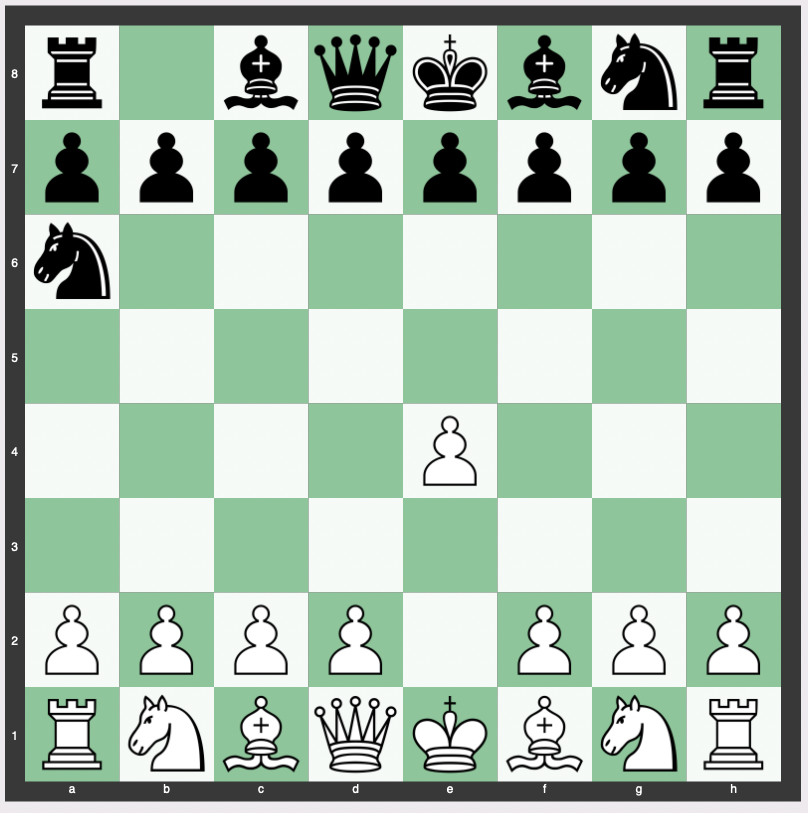The Lemming Defense, marked by the move 1… Na6, stands as an unorthodox and intriguing response to 1.e4 in the game of chess.
As the name “Lemming Defense” suggests, it can be a risky and unconventional path for the player with the black pieces.
Here we look at the unique characteristics of this defense, the theory and strategy behind it, its variations, historical context, and its appropriateness for different skill levels.
By the end of this examination, readers will have a comprehensive understanding of this peculiar yet captivating chess opening.
Move Order of the Lemming Defense
- e4 Na6

This move order defines the Lemming Defense, with White opening the game with the central pawn push 1.e4 and Black responding with 1…Na6, developing the knight to an arguably inferior square on the a6 file.
Theory, Strategy and Purpose of the Lemming Defense
The Lemming Defense is known for its unexpected nature.
Developing the knight to the a6 square is not typically part of standard opening principles.
Despite appearing inferior, the move can lead to unique and non-traditional positions, catching opponents off guard.
In some cases, the Na6 knight can be rerouted to more central squares later in the game.
The Lemming Defense is evaluated at approximately +1.30 to +1.40, favoring white.
Variations of the Lemming Defense
There are various ways the game can progress after 1…Na6.
Both players have numerous continuations and potential middlegame plans.
White often responds with the standard 2. Nf3 and sometimes 2. Nc3.
These variations can lead to both open and closed positions, depending on the chosen paths.
The unorthodox nature of the Lemming Defense ensures that the typical theory might not apply, leading to fresh and unconventional games.
Sample Continuation Lines of the Lemming Defense
Some sample lines from the Lemming Defense include:
2. Nf3 e6 3. d4 d5 4. exd5 exd5 5. Bxa6 bxa6 6. Qe2+ Qe7 7. Be3 Qe6 8. O-O Nf6 9. Re1 Bd6
2. Nf3 e6 3. Nc3 d6 4. Bb5+ c6 5. Bxa6 bxa6 6. d4 Nf6 7. O-O Bb7 8. Qe2 Nd7 9. Bg5 Be7 10. Bxe7 Qxe7 11. e5 dxe5 12. Nxe5
2. Nf3 e6 3. Nc3 d6 4. Bb5+ c6 5. Bxa6 bxa6 6. d4 Bb7 7. Qe2 Be7 8. Bf4 Nf6 9. O-O-O d5 10. h4 dxe4 11. Ne5
2. Nf3 d6 3. Bb5+ c6 4. Bxa6 bxa6 5. d4 Nf6 6. Qe2 Bg4 7. Nbd2 e6 8. O-O Be7 9. Qxa6 O-O 10. h3 Bxf3 11. Nxf3 Nxe4 12. Qxc6
History of the Lemming Defense
The Lemming Defense has not been widely adopted in historical chess practice.
It has occasionally been employed as a surprise weapon in certain games.
The opening owes its name to the characterization in “Unorthodox Chess Openings,” reflecting its risky nature, akin to a lemming venturing into dangerous territory.
Is the Lemming Defense Good for Beginners or Intermediates?
For beginners, the Lemming Defense may be challenging to handle due to its deviation from classical opening principles.
Intermediate players might find it an interesting experiment, as it can lead to less-explored positions.
It requires a deep understanding of middlegame strategy to compensate for the unorthodox opening development.
How Often Is the Lemming Defense Played at the Grandmaster Level?
The Lemming Defense is rarely seen at the Grandmaster level.
Top players typically prefer well-established openings with proven strategic foundations.
Occasionally, it might be used as a surprise weapon in less critical games or when a player wants to avoid well-prepared lines.
ECO B00 Lemming defense (White perspective)
Conclusion
The Lemming Defense, marked by the move 1…Na6, is an intriguing and unconventional opening response to 1.e4.
While it may appear inferior at first glance, it holds a complex and multifaceted nature, providing opportunities for surprise and creativity.
However, its rarity in top-level play and deviation from classical opening principles may make it less suitable for beginners.
For those willing to explore the road less traveled in chess, the Lemming Defense may offer an exciting and unexplored landscape, full of possibilities and unexpected twists.
Related


